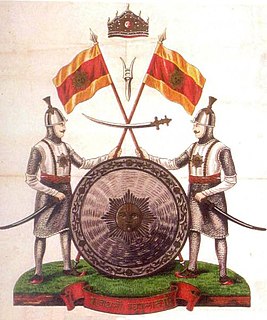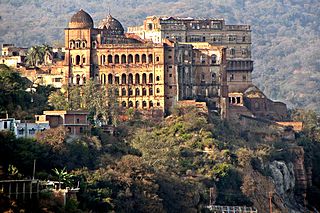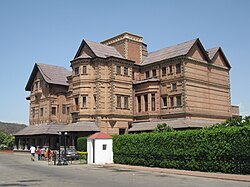
Maharaja Sir Hari Singh was the last ruling Maharaja of the princely state of Jammu and Kashmir.
The Dogras or Dogra people, are an Indo-Aryan ethno-linguistic group in India and Pakistan consisting of the Dogri language speakers. They live predominantly in the Jammu region of Jammu and Kashmir, and in adjoining areas of Punjab, Himachal Pradesh, and northeastern Pakistan. Their historical homeland is known as Duggar.

Raghunath Temple is a Hindu temple located in Jammu in the Indian union territory of Jammu and Kashmir. It consists of a complex of seven Hindu shrines. Raghunath Temple was constructed by the first Dogra ruler Maharaja Gulab Singh in the year 1835 and later his son Maharaja Ranbir Singh got it completed in the year 1860 During Dogra rule. The temple has many gods in its complex of shrines, but the presiding deity is Rama – also known as Raghunath, an Avatar of Vishnu. All the spiral-shaped towers have gold plated spires. The niches in the walls of the shrines are decorated with 300 well-crafted icons of gods and goddesses including those of Surya and Shiva, but most are particularly related to the life stories of Rama and Krishna. The paintings in the 15 panels of the main shrine are based on themes from Ramayana, Mahabharata, and Bhagavad Gita. The temple premises include a school and a library that preserves over 6,000 manuscripts in many Indian languages, with a notable collection of Sarada script Sanskrit manuscripts.

Junagarh Fort is a fort in the city of Bikaner, Rajasthan, India. The fort was originally called Chintamani and was renamed Junagarh or "Old Fort" in the early 20th century when the ruling family moved to Lalgarh Palace outside the fort limits. It is one of the few major forts in Rajasthan which is not built on a hilltop. The modern city of Bikaner has developed around the fort.

Basohli is a town near Kathua in Kathua district in the union territory of Jammu and Kashmir, India. It is situated on the right bank of River Ravi at an altitude of 1876 ft. It was founded by Raja Bhupat Pal sometime in 1635. It was known for the palaces which are now in ruins and miniatures paintings. The Battle of Basoli was fought in this region.

Chamba is a town in the Chamba district in the Indian state of Himachal Pradesh. According to the 2001 Indian census, Chamba has a population of 20,312 people. Located at an altitude of 1,006 metres (3,301 ft) above mean sea level, the town is situated on the banks of the Ravi River, at its confluence with the Sal River.

Karan Singh is an Indian politician and philosopher. He is the son of the last ruling Maharaja of the princely state of Jammu and Kashmir, Sir Hari Singh. He was the prince regent of Jammu and Kashmir until 1952. From 1952 to 1965 he was the Sadr-i-Riyasat (President) of the state of Jammu and Kashmir in the Republic of India. He is the chairperson trustee of the Dharmarth Trust of Jammu and Kashmir which maintains 175 temples in north India and works in other areas such as historical preservation.

Jamwal is a toponymic surname for a Dogra Rajput clan of the same name from Jammu, in Jammu and Kashmir, India. They claim descent from the traditional founder of Jammu, Jambu Lochan, and there at one time some of their members were rulers of the princely state of Jammu and Kashmir, often referred to as the Dogra dynasty.

Jasrota kingdom in the Himalayan foothills of India was founded in 1064 A.D at south-eastern Jammu between the Ravi and the Ujh rivers which ended in 1815. The remainants of Jasrota kingdom exists as ruined forts, restored temples, water bodies and canals in Hiranagar tehsil, Narowal tehsil, Nagri tehsil, Kathua tehsil, Marheen tehsil, Dinga Amb tehsil, Ramkot tehsil, Mahanpur tehsil, Billawar tehsil.

The Dogra dynasty Dogra Rajput Hindu from Shiwalik Himalayas created Jammu and Kashmir when all dynastic kingdoms in India were being absorbed under East India Company. Events led Sikh Empire to recognise Jammu as a vassal state in 1820, and later the British added Kashmir to Jammu by the Treaty of Amritsar in 1846. The founder of the dynasty, Gulab Singh, was an influential noble in the court of Maharaja Ranjit Singh of Lahore, while his brother Dhian Singh served as the prime minister of the Sikh empire. Appointed by Ranjit Singh as the hereditary Raja of the Jammu principality, Gulab Singh established his supremacy over all the hill states surrounding the Kashmir Valley. After the First Anglo-Sikh War in 1846, under the terms of the Treaty of Lahore, 1846, the British Indian government acquired Kashmir from the Sikh Empire and transferred it to Gulab Singh, recognising him as an independent Maharaja. Thus Jammu and Kashmir was established as one of the largest princely states in British India, receiving a 21-gun salute for its Maharaja in 1921. It was ruled by Gulab Singh and his descendants till 1947.

Kangra painting is the pictorial art of Kangra, named after the Kangra State, a former princely state of Himachal Pradesh, which patronized the art. It became prevalent with the fading of Basohli school of painting in mid-18th century, and soon produced such a magnitude in paintings both in content as well as volume, that the Pahari painting school, came to be known as Kangra paintings.

The Hari Niwas Palace is a palace in Jammu, India. It overlooks the Tawi river on one side and on the other side the Trikuta hills.

Mubarak Mandi is a palace in Jammu, India. The palace was the royal residence of the maharaja of Jammu and Kashmir from the Dogra dynasty. It was their main seat till 1925 when maharaja Hari Singh moved to the Hari Niwas Palace in the northern part of Jammu. The palace is located in the heart of the old walled city of Jammu and overlooks the Tawi river.
The term Dogra Rajput refers to a number of Dogri speaking Rajput clans found in the Jammu region and parts of Himachal Pradesh. Dogra Rajput dynasty ruled Jammu and Kashmir till 1947. Hari Singh was the last ruler of this dynasty.
Dogra Art Museum, Jammu previously known as the Dogra Art Gallery is a museum of Dogra cultural heritage housed in the Pink Hall of the Mubarak Mandi complex, Jammu, India. The main attractions of the museum are the Pahari miniature paintings from Basohli.

The Jammu division is a revenue and administrative division within Jammu and Kashmir, a union territory of India. It consists of the districts of Jammu, Doda, Kathua, Ramban, Reasi, Kishtwar, Poonch, Rajouri, Udhampur and Samba. Most of the land is hilly or mountainous, including the Pir Panjal Range which separates it from the Kashmir Valley and part of the Great Himalayas in the eastern districts of Doda and Kishtwar. Its principal river is the Chenab.

Jammu is the winter capital of the Indian union territory of Jammu and Kashmir. It is the headquarters and the largest city in Jammu district of the union territory. Lying on the banks of the river Tawi, the city of Jammu, with an area of 240 km2 (93 sq mi), is surrounded by the Himalayas in the north and the northern-plains in the south. Jammu is the second most populous city of the union territory. Two battles have been fought in the city: the first in 1712 and the second in 1808.

Guler was a small precolonial Indian hill state in the Lower Himalayas. Its capital was the town of Haripur Guler, in modern-day Himachal Pradesh. The kingdom was founded in 1415 by Raja Hari Chand, a scion of the ancient royal family of Kangra.
YuvrajVikramaditya Singh is an Indian businessman and politician. He was a leader of Indian National Congress (INC) and an ex-member of Jammu and Kashmir Legislative Council. He is the grandson of Maharaja Sir Hari Singh, who was the last reigning Maharaja of Jammu and Kashmir. He is the heir apparent of the Dogra dynasty.
Chitrangada Singh is an Indian businesswoman and a descendant of the former ruling family of a major princely state during the British Raj in India.





















